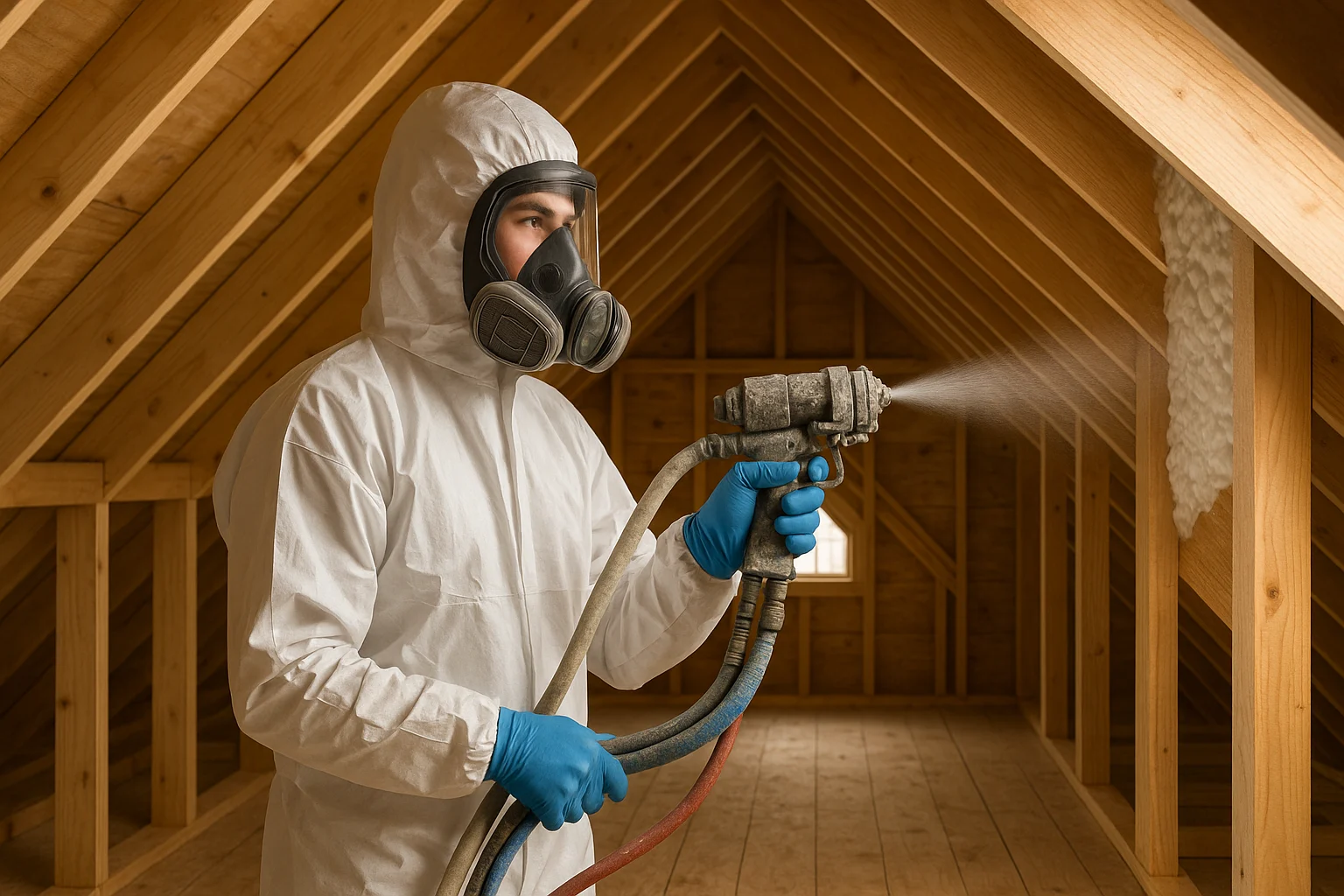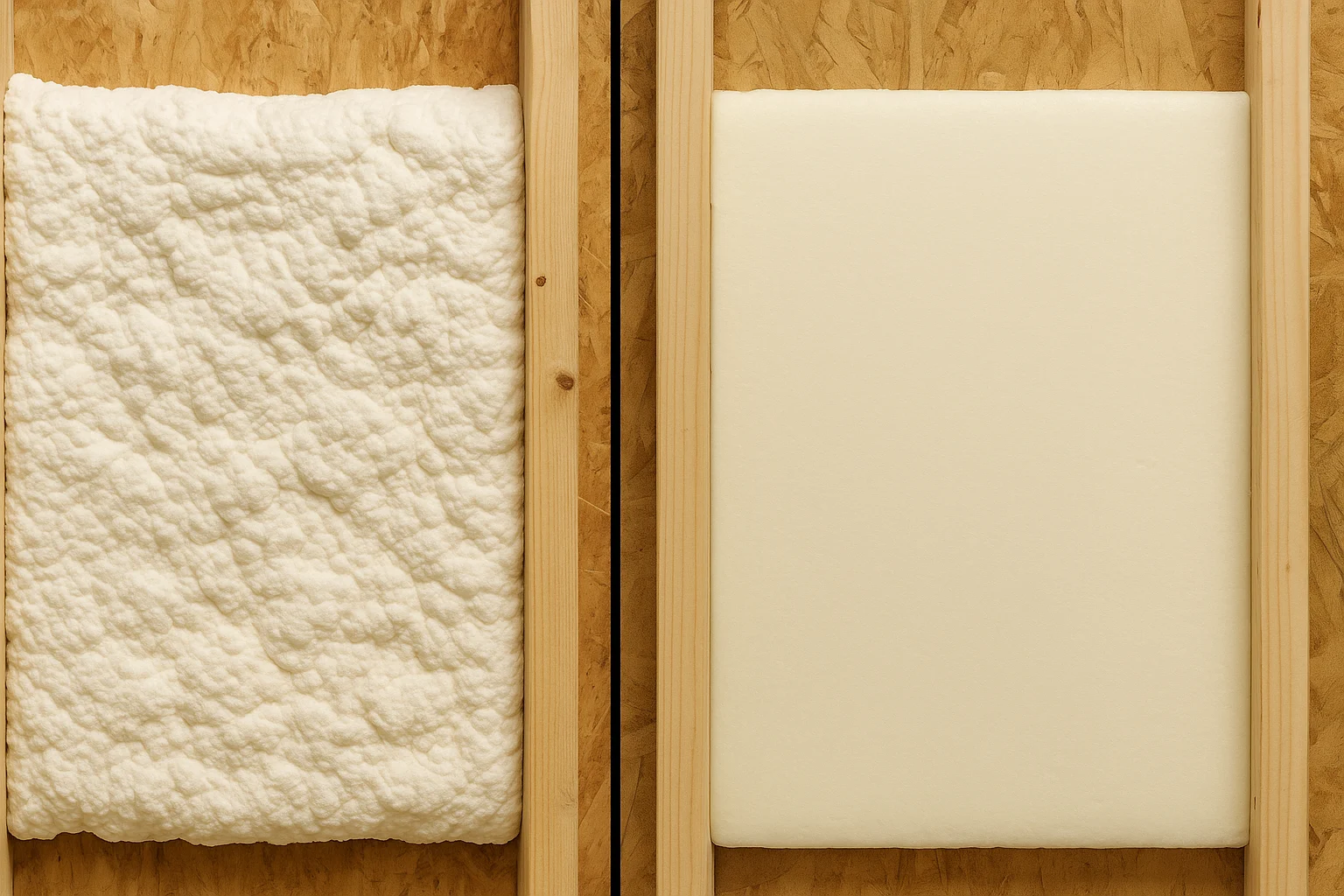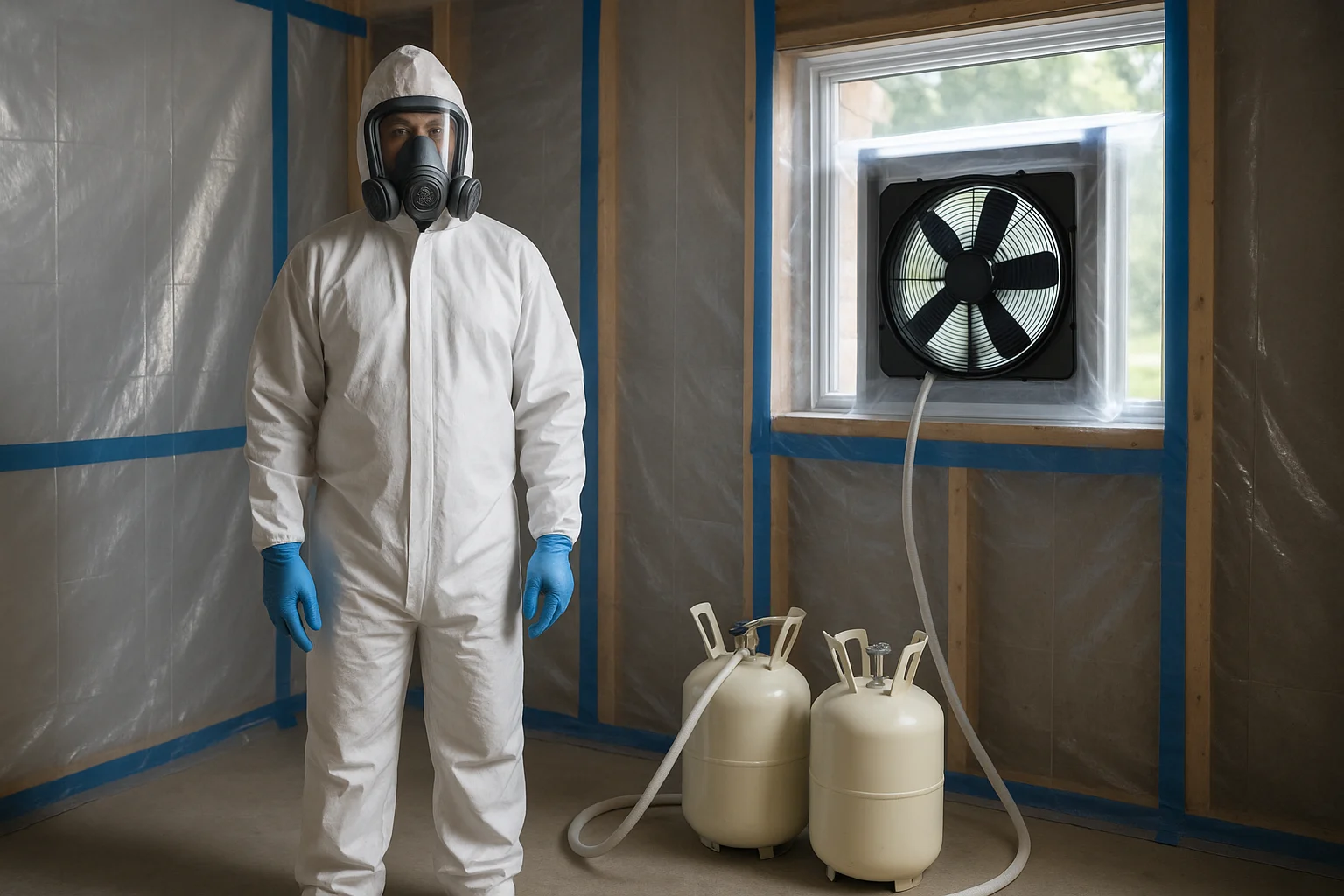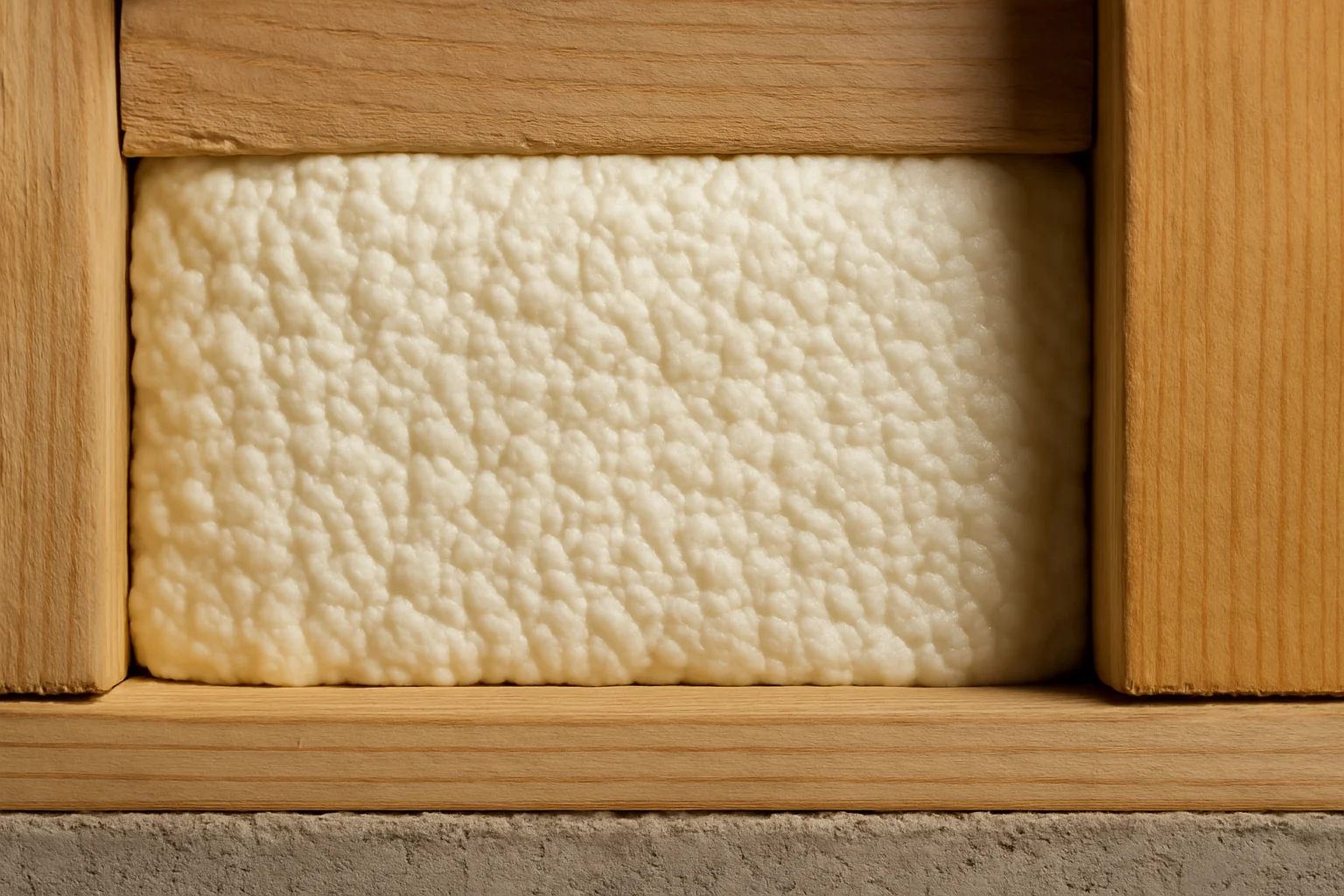
Drafts and high bills usually come from air leaks, not just thin insulation. DIY insulation spray foam seals and insulates in one pass—if you choose the right foam and apply it safely. Here’s the quick-hit playbook: when to use open vs. closed cell, the PPE that’s non-negotiable, code basics you can’t skip, simple cost math to size a kit, and a step-by-step process that avoids common mistakes. No fluff—just what you need to get a tighter, more comfortable home. For the bigger picture on rebates and credits, see energy efficient home improvement credits.
Spray Foam Fit Finder
Pick your project area, moisture exposure, and current insulation level. You’ll get a foam type, target thickness, and savings outlook.
Project Area
Moisture Exposure
Current Insulation
Pick options to see your plan
Recommendations will appear here after you choose at least the project area.
💡 Tip: Try switching “Moisture” to see how the foam type changes.
Table of Contents
- Key Takeaways for DIY Spray Foam
- diy insulation spray foam: Open-Cell vs Closed-Cell
- Is DIY Right? Pros and Cons
- Safety & PPE for Spray Foam
- Tools and Materials You’ll Need
- Best Places to Spray Foam (Attic, Rim Joist, Crawl)
- Prepping Your Project Area
- Step-by-Step: Setup, Spray, Cure
- Costs: DIY vs Pro
- Quick Answers (Common Searches)
- Common Mistakes to Avoid
- Maintenance and Longevity of Your DIY Spray Foam
- Frequently Asked Questions
- Conclusion
Seal the leaks, cut the bills — master DIY spray foam insulation like a pro.
If rooms swing from chilly to stuffy and bills keep climbing, air is slipping through gaps. This guide shows exactly where foam wins, what to spray (and where not to), and how to work safely without wasting a kit. Expect clear steps, code basics, and practical tips from real-world jobs.
Key Takeaways for DIY Spray Foam
- Safety First, Always: Before starting any DIY spray foam project, prioritize personal protective equipment (PPE) like respirators, gloves, and eye protection. Proper ventilation is also crucial.
- Choose the Right Foam: Understand the difference between open-cell (flexible, sound-dampening) and closed-cell (dense, moisture-resistant) spray foam to pick the best option for your specific project areas like attics, crawl spaces, or rim joists.
- Preparation is key: Mask what you don’t want foamed, make sure surfaces are dry, and double-check the temp range so the foam expands and sticks the way it should.
- Dial in your technique: Do a quick test spray, then build thin, even passes with a steady sweep. Pause to swap nozzles before they clog so you don’t waste material or slow the cure.
- Significant Savings Possible: DIY spray foam can lead to substantial energy bill reductions, often paying for itself over time. While professional installation offers convenience, doing it yourself can save a significant amount on labor costs.
This post contains affiliate links. If you buy through our links, we may earn a commission at no extra cost to you. Learn more.
Not sure about a step or safety detail? When you’d rather ask than guess, a quick expert check can save time and rework.
diy insulation spray foam: Open-Cell vs Closed-Cell

Spray foam insulation isn’t just another insulation material; it’s a game-changer for home energy efficiency. Unlike traditional fiberglass batts or cellulose, spray foam expands to fill every crack and crevice, creating an airtight seal that dramatically reduces air leakage. This makes it incredibly effective at keeping your home warmer in winter and cooler in summer.
What is Spray Foam Insulation?
At its core, spray foam insulation is a chemical product that comes in two separate liquids (an isocyanate and a polyol resin). When these liquids are mixed together at the tip of a spray gun, they react, expand, and then harden into an insulating foam. This expansion is what allows it to conform to any shape, sealing off areas that traditional insulation simply can’t reach.
The Benefits of DIY Spray Foam Insulation
Choosing spray foam as a DIY project offers a range of advantages for homeowners:
- Superior air sealing: Foam kills the sneaky leaks that drive up bills—like putting a snug windbreaker on the whole house. 🌬️
- High R-value: Per inch, foam resists heat flow extremely well; closed-cell in particular sits at the top of the insulation chart.
- Energy Bill Reduction: By sealing leaks and providing excellent insulation, spray foam can significantly lower your heating and cooling costs. Many homeowners report savings of 15-30% or even more!
- Moisture Barrier: Closed-cell spray foam acts as an excellent moisture barrier, preventing water vapor from penetrating walls and leading to mold or rot. This is especially valuable in damp areas like crawl spaces.
- Sound Dampening: Both open-cell and closed-cell foams can help reduce noise transmission, making your home quieter and more peaceful. Open-cell is particularly effective for sound absorption. 🤫
- Increased Structural Integrity (Closed-Cell): The rigidity of closed-cell foam can add a bit of structural strength to walls and joists where it’s applied.
- Pest Deterrent: The dense, hard nature of cured foam makes it difficult for pests to tunnel through, offering an additional layer of protection against unwanted guests. 🕷️🚫
Open-Cell vs. Closed-Cell Spray Foam: Choosing Your Weapon
| Feature | Open-Cell Spray Foam | Closed-Cell Spray Foam |
|---|---|---|
| Structure | Cells are intentionally left open, trapping air. | Cells are completely closed and packed together. |
| Density | Less dense, lighter, sponge-like texture. | Very dense, rigid, hard texture. |
| Expansion | Expands significantly (up to 150x liquid volume). | Expands less (up to 40x liquid volume). |
| R-Value per inch | R-3.5 to R-3.7 | R-6.0 to R-7.0 |
| Air Sealing | Excellent. | Excellent. |
| Moisture Barrier | Poor (permeable to water vapor). | Excellent (impermeable to water vapor). |
| Sound Dampening | Superior (absorbs sound well). | Good (reduces sound transmission). |
| Cost | Generally less expensive per board foot. | Generally more expensive per board foot. |
| Best Uses | Interior walls, ceilings, soundproofing, attics (vented). | Basements, crawl spaces, exterior walls, rim joists, attics (unvented), areas needing structural rigidity. |
| DIY Suitability | Easier to work with, more forgiving for beginners. | More challenging due to density and less expansion. |
“Understanding the unique properties of open-cell versus closed-cell foam is like choosing the right tool for the job—it drives how well the project performs years from now.”
Is DIY Right? Pros and Cons
Doing it yourself can save real money, but it also puts you in charge of safety, setup, and results. Here’s a quick, honest look at both paths.
Pros of DIY Spray Foam
- Cost savings: Labor drops off the bill, which is why small, targeted jobs often pencil out best.
- Control and Flexibility: You set the schedule and work at your own pace. You also have direct control over the quality of the application (assuming you follow best practices).
- Learning Experience: For the dedicated DIYer, it’s a rewarding way to learn a new skill and gain a deeper understanding of your home’s construction.
- Immediate Impact: You can often feel the difference in comfort and notice the energy savings very quickly after the project is complete.
Cons and Challenges of DIY Spray Foam
- Safety risks: You’re working with reactive chemicals—follow the SDS and PPE rules or don’t proceed.
- Learning curve: Consistent layers take practice; uneven passes mean trim-backs, touch-ups, and wasted board feet.
- Gear costs: Kits cover small jobs; bigger areas may demand rentals or pro-grade tools that add to the bill.
- Mess factor: Overspray travels and sticks to everything; contain the area or you’ll be scraping for days.
- Time trade-off: Even small projects soak up prep, spray time, trimming, and cleanup.
Safety & PPE for Spray Foam

Safety first. Spray-foam chemicals are reactive, so treat them with respect. Wear proper PPE, ventilate well, and follow the product SDS. Is DIY spray foam insulation safe to apply? Yes—if you use the right gear, prep the space, and stick to the instructions.
Personal Protective Equipment (PPE) 😷🧤👓
- Respirator: Full-face with organic vapor cartridges (NIOSH-approved P100 or higher). Do NOT use a dust mask.
- Chemical-Resistant Gloves: Nitrile or butyl rubber to protect hands.
- Eye Protection: Safety glasses or goggles even with a full-face respirator.
- Full-Body Protective Suit: Disposable Tyvek-style suit to protect skin and clothing.
- Head Covering: Hood or cap for hair protection.
- Closed-Toe Shoes: Protect feet from spills and debris.
Ventilation 🌬️
- Exhaust Fans: Use powerful exhaust fans to draw air out of the work area and vent outdoors.
- Fresh Air Supply: Ensure there’s a source of fresh, clean air entering the space.
- Isolate the Work Area: Close off the area from the rest of the house to prevent fumes spreading.
- Vacate the Premises: No one else (especially children or pets) should be in the house during application and for 24–72 hours after, per product guidance.
Re-entry and ventilation times vary by manufacturer and job size; always follow the product SDS and local code. For large or occupied spaces, consider hiring a certified spray-foam contractor.
Material Safety Data Sheets (MSDS)
Before you even open a kit, read the Manufacturer’s Safety Data Sheets (MSDS) for your specific spray foam product to understand hazards, handling, and first aid. For additional background, see OSHA guidance on isocyanates.
First Aid and Emergency Plan
- Know the Symptoms: Eye irritation, skin rash, difficulty breathing, or dizziness.
- Have a Plan: Know who to call and what to do in case of accidental exposure.
- First Aid Kit: Keep a stocked kit nearby.
- Eye Wash Station: For larger projects, keep an eyewash station ready.
Tools and Materials You’ll Need
Equipping yourself with the right tools and materials is the first step toward a successful DIY spray-foam project.
The DIY Spray Foam Kit
For homeowners, the most common option is a two-component DIY kit—sometimes labeled a do it yourself spray foam insulation kit—often marketed as a diy spray insulation kit or a spray insulation diy kit. These kits come with tanks, hoses, gun, nozzles, and basic PPE (upgrade yours for quality);
Essential Tools & Supplies
- Utility knife or foam saw for trimming cured foam
- Drop cloths/plastic sheeting and masking tape
- Respirator, gloves, disposable coveralls (enhanced PPE)
- Ventilation fans and work lights
- Infrared thermometer; cleaning solvent; tape measure; sealant/caulk; extension cords
Best Places to Spray Foam (Attic, Rim Joist, Crawl)

Understanding where spray foam performs best will maximize effectiveness and ROI.
Attics
- Unvented: Closed-cell on the roof deck brings the attic into the conditioned envelope and may help prevent ice dams.
- Vented (floor application): Open-cell on the attic floor seals and insulates the ceiling below (see our attic insulation DIY guide).
- Gable Ends: Seal triangular walls to cut leakage.
Crawl Spaces
- Walls and Rim Joists: Closed-cell creates a sealed, insulated perimeter that reduces moisture and drafts.
- Floor Joists: Open-cell under subfloor helps, though full encapsulation handles ground moisture best.
Basement Walls
Closed-cell on interior foundation walls blocks moisture and heat loss; cover with framing and drywall (for moisture management steps, see DIY basement waterproofing).
Rim Joists
Quick, high-ROI project: Closed-cell foam seals the band joist where infiltration is common.
Small to Medium Projects
- Low-expansion foam around windows/doors (to avoid bowing)
- Seal gaps around pipes, wires, vents and DIY duct sealing
- Insulate garage doors or shed interiors
If those window/door gaps are the main culprit, comparing local repair vs. replacement quotes can clarify your best next move.
When NOT to Use DIY Spray Foam
- Electrical boxes/wiring without required clearances
- Hot surfaces (chimneys, flues, hot pipes)
- Enclosed cavities without proper venting
- Wet or dirty surfaces
Prepping Your Project Area
In many jurisdictions, foam needs a 15-minute thermal barrier (IRC R316)—typically 1/2-in drywall or a tested intumescent coating. Some attics and crawls allow ignition barriers instead. Think moisture, too: closed-cell often serves as a Class II vapor retarder; open-cell may need a separate retarder in cold zones. Aim for 65–85°F, low humidity, and stay above the dew point. Size the kit as sq ft × inches of thickness, then add 10–15% for waste. Use fan nozzles for wide bays and cone nozzles for detail work.
- Clear the Area: Remove furniture, tools, and anything that might get in the way.
- Clean Surfaces: Surfaces must be clean, dry, and free of dust, oil, and debris.
- Mask Off Everything Else: Use plastic and tape to protect adjacent surfaces.
- Remove Old Insulation (If Necessary): Especially in attics/crawl spaces for proper adhesion.
- Seal Large Gaps: Pre-fill 1–2+ inch gaps with backer rod, plywood, or expanding caulk.
- Check Temperature and Humidity: Keep to manufacturer ranges; use an IR thermometer.
- Ensure Adequate Lighting: See your coverage clearly.
- Test Equipment: Dial in flow and expansion on scrap.
Step-by-Step: Setup, Spray, Cure
- Prepare the Tanks: Warm and shake both A and B tanks 30–60 seconds each.
- Connect Hoses and Gun: Match A-to-A, B-to-B; attach fresh nozzle.
- Test the Spray: Full trigger on cardboard; look for uniform expansion and mix before committing your spray insulation diy kit to a bay.
- Apply the Foam: Hold 12–24 in from surface; sweep evenly; build 1–2 in layers; focus corners and penetrations.
- Nozzles: Replace after pauses >30 seconds or inconsistent spray.
- Trim Excess: After cure, trim flush with knife or foam saw.
- Curing & Re-entry: Follow product guidance (often 24–72 hours) with ventilation.
- Clean Up: Dispose per local rules; store/dispose tanks properly.
Costs: DIY vs Pro
Many homeowners ask, “how much does a spray foam insulation cost?” The short version: kit prices and board-foot needs drive DIY totals, while pro quotes bundle labor, setup, and access—below we compare both.
Quick Answers (Common Searches)
Below are quick clarifications for common searches. Skim what matches your project.
- People use diy insulation foam, spray foam insulation diy, do it yourself spray insulation, and DIY spray-foam work to mean similar work—focus on method, safety, and temperature windows.
- For value and reliability, the best DIY kit often means choosing a kit; shoppers compare the best diy spray foam insulation kit and the best diy foam insulation kit, and many pick a diy polyurethane spray foam insulation kit for closed-cell performance.
- Budgeting labels vary: spray insulation diy cost, spray foam insulation cost diy, diy spray insulation cost, and do it yourself spray foam insulation cost—use area × inches + 10–15% waste, then add PPE and containment.
- Wondering why is spray foam insulation so expensive? Chemistry, safety controls, yield variability, and shipping weight drive pricing.
- Before you start, skim a primer; guides on how to diy spray foam insulation and how to do spray foam insulation yourself stress thin lifts, nozzle swaps, and temperature control.
- For tiny gaps, how to apply spray foam insulation in a can is simpler than mixing a two-component kit.
- DIY feasibility: people ask can you do spray foam insulation yourself, can you diy spray foam insulation, or can you apply spray foam insulation yourself; small zones are doable with proper PPE, while big attics are usually pro work.
- Attics and overhead: read up on how to spray foam insulation in attic; remember spray foam insulation ceiling do it yourself requires extra containment and eye protection.
- Stud bays: diy spray foam insulation for walls air-seals quickly before drywall if you keep passes thin and even.
- Existing walls: spray foam insulation in existing walls diy, diy foam insulation existing walls, do it yourself foam insulation existing walls, and diy spray foam insulation existing walls rely on small access holes—locate wiring/plumbing first.
- Dense cavities may suit diy injection foam insulation existing walls; if you’re asking can you add spray foam insulation to existing walls, yes via access holes—verify vapor control for your climate.
- Amount needed: a quick how much spray foam insulation do i need calculator uses area × thickness (inches) to estimate board feet—then add waste.
- Buying & pros: big-box listings like spray foam insulation do it yourself home depot are fine; for benchmarks, call a couple of locals under who does spray foam insulation in my area and compare yield vs. quotes.
- Cleanup: check how to dissolve spray foam insulation in the SDS—mechanical removal is most common.
- Choosing material: if you’re unsure which spray foam insulation is best, go closed-cell for damp zones or rigidity, open-cell for sound control and vented attics.
Common Mistakes to Avoid
- Inadequate PPE
- Poor surface prep
- Ignoring temperature/humidity limits
- Spraying too thick in one pass
- Not testing flow before starting
- Running out of material mid-project
- Improper ventilation
- Overspraying and not replacing clogged nozzles
Maintenance and Longevity of Your DIY Spray Foam
Once your spray-foam project is complete, you’ll want to ensure it continues to perform for years. Properly applied foam can last the lifetime of your home. Inspect accessible areas periodically for damage, pests, leaks, or unusual discoloration, and repair small sections with a small kit or single-component foam as needed.
Aftercare: quick inspection routine
Give the work a once-over at 30 days, then every season. Look for cracks from movement, discoloration from moisture, or gaps near pipes and wiring. Small flaws are easy to fix early—shave any high spots, top up thin sections, and reseal edges that see airflow. In crawl spaces and basements, run a quick humidity check; if readings creep up, address drainage or add dehumidification so the foam isn’t fighting a wet assembly.
Frequently Asked Questions
Conclusion
Taking on a DIY spray-foam project can dramatically improve comfort and efficiency. Understand the foam types, prioritize safety, prep well, and follow the step-by-step method to get pro-level results while saving real money.
This guide is educational and general in nature. It is not tax or legal advice. Consult a qualified professional for your specific situation.